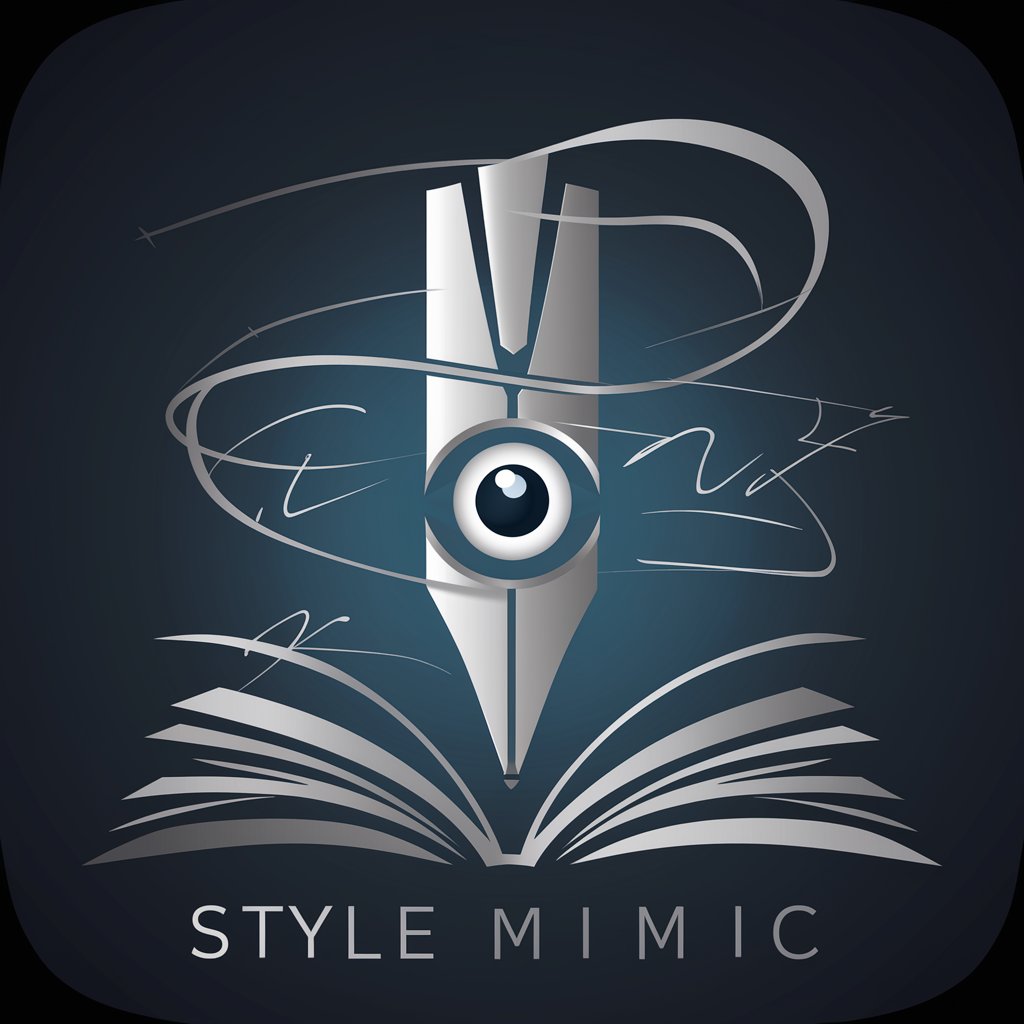Style Mimic - Style Emulation AI Tool

Welcome! Let's transform your writing.
Transform your writing with AI-powered style mimicry.
Rewrite this paragraph in a playful tone:
Transform this text to match the style of a minimalist writer:
Emulate the style of this document in a theatrical manner:
Convert this formal text into an informal, conversational tone:
Get Embed Code
Introduction to Style Mimic
Style Mimic is designed as a specialized digital assistant focused on analyzing and emulating writing styles. It examines uploaded files to understand the voice, tone, style, and structure of the text. Whether the original text is informal, theatrical, sarcastic, playful, minimalist, or follows a unique structural pattern, Style Mimic adapts to these characteristics and applies them to the text input provided by the user. This functionality allows for a wide range of applications, from creative writing enhancements to professional document adaptation, ensuring that the output aligns with the desired stylistic approach. For example, if a user uploads a file containing a series of playful and engaging blog posts, Style Mimic can then rewrite a provided corporate newsletter in a similar playful and engaging manner, transforming the communication to better engage its audience. Powered by ChatGPT-4o。

Main Functions of Style Mimic
Style Analysis
Example
After uploading a piece of classical literature, Style Mimic identifies its complex sentence structures, rich vocabulary, and descriptive imagery.
Scenario
A novelist wants to write a chapter of their book mimicking the style of a classic author to pay homage.
Tone Adaptation
Example
Given a set of technical documents, Style Mimic adjusts the tone to make an academic paper more accessible to a general audience.
Scenario
A researcher aims to share their findings on social media, requiring a shift from a formal to a more conversational tone.
Structural Replication
Example
Analyzing a screenplay, Style Mimic captures its formatting, dialogue pacing, and scene descriptions to guide the user in crafting their own screenplay.
Scenario
An aspiring screenwriter needs help formatting their script according to industry standards, using a famous screenplay as a model.
Voice Emulation
Example
By studying personal letters from a historical figure, Style Mimic can help a user write a fictional diary entry as if penned by that figure.
Scenario
A historical fiction author wants to create authentic-sounding diary entries from the perspective of a well-known historical figure.
Ideal Users of Style Mimic Services
Creative Writers
Authors, poets, and playwrights looking to experiment with different writing styles or seeking inspiration from various sources. Style Mimic can help them understand and apply different tones and structures to their work, enhancing creativity and depth.
Professional Communicators
This includes marketers, corporate communicators, and content creators who need to adapt their messaging across different platforms and audiences. Style Mimic enables them to tailor their communication style to fit the expectations and preferences of their target audience, ensuring effectiveness and engagement.
Educators and Students
Teachers can use Style Mimic to introduce students to various writing styles and techniques, while students can use it to better understand how to craft their essays, reports, and creative writing projects in the styles of different authors or to meet specific academic standards.
Researchers and Academics
Individuals in this group can benefit from Style Mimic by translating complex research findings into more accessible language for public dissemination or by adopting a particular academic style for submitting papers to journals and conferences.

How to Use Style Mimic
1
Start your journey at yeschat.ai for a no-cost trial, accessible immediately without needing to sign up for ChatGPT Plus.
2
Upload a text file that exemplifies the writing style you wish to emulate. This can be any document whose tone, style, and structure you'd like your text to mirror.
3
Input the text you want transformed into the style of the uploaded document. Ensure your input is clear and structured to facilitate an accurate style transformation.
4
Review the output provided by Style Mimic. If the result doesn't perfectly match your expectations, consider adjusting the input text or uploading a different style reference.
5
Utilize feedback options to refine the style emulation. Your input helps Style Mimic learn and improve, ensuring better alignment with your stylistic preferences over time.
Try other advanced and practical GPTs
Supervisor de Psicólogos
Empowering Mental Health Professionals with AI

Moana Style Storyboard
Bringing Characters to Life with AI

Reign Hunter CBJ, Insurance Commissioner
Empowering Insurance Decisions with AI

DivineAlgorithm.ai - HDF - AGI Simulation
Navigating AGI Futures with AI-Powered Precision

Faithful Counselor
Navigating faith with AI-powered wisdom.

Interview Coach
Ace Your Interview with AI-Powered Coaching

Resolution Assistant
Empowering Your Goals with AI

QiPao-cheongsam cocreate
Empowering Cheongsam Creativity with AI

GPTChing
Unlock ancient wisdom with AI
M Code Formatter by JP
Refine code with AI, following Microsoft standards.

OrdinalGPT
Exploring Bitcoin Ordinals with AI

Scaffolder
Streamline Your Web Development with AI-Powered Scaffolding

Frequently Asked Questions about Style Mimic
What types of text can Style Mimic emulate?
Style Mimic can emulate a wide range of text types, from formal academic language to casual blog posts, including theatrical, sarcastic, and playful tones.
Is Style Mimic capable of emulating the writing style of specific authors?
Yes, provided you upload a text sample of the author's work, Style Mimic can analyze and emulate the specific stylistic elements of that author's writing.
How does Style Mimic ensure the quality of its style emulation?
Style Mimic uses advanced AI algorithms to analyze the uploaded text for its stylistic traits and then applies these traits to your input text, continuously learning from user feedback to improve.
Can Style Mimic handle multiple languages?
Currently, Style Mimic is optimized for English language texts. Its ability to accurately emulate styles in other languages may vary based on the complexity of the language and the availability of stylistic examples.
Is there a limit to the length of text Style Mimic can process?
There may be practical limits based on processing power and the complexity of the style being emulated. For best results, focus on shorter, more manageable sections of text for emulation.
